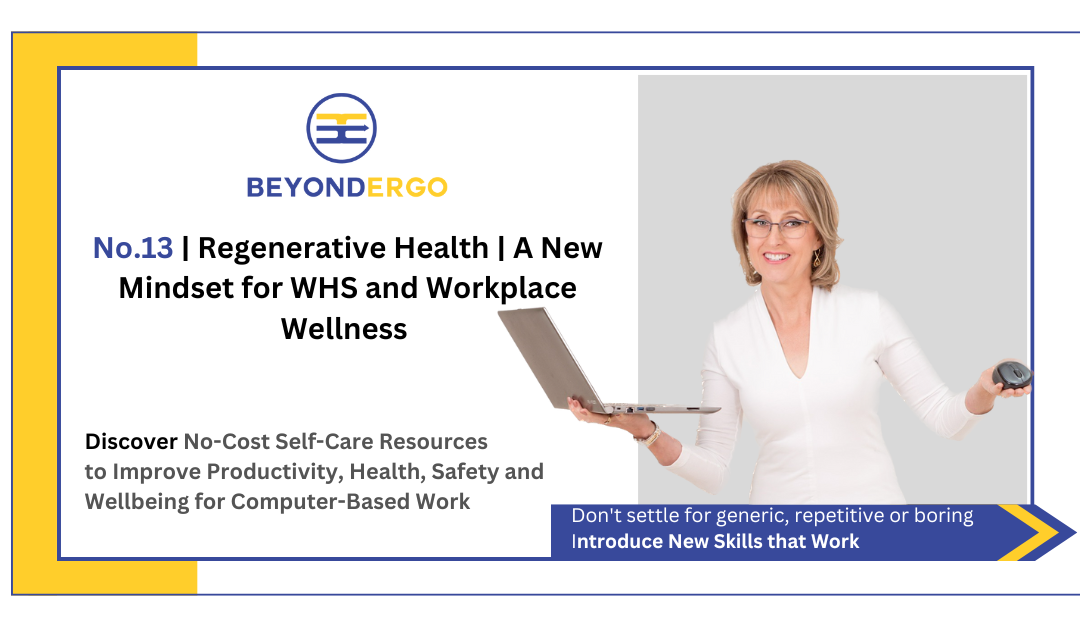Great leaders don’t just manage risks—they create environments where people thrive.
Workplace Health and Safety (WHS) and wellness programs are evolving, and the shift to regenerative health presents an opportunity for forward-thinking leaders to drive lasting change.
Regenerative health goes beyond traditional wellness models by fostering a holistic, proactive, and sustainable approach to workplace well-being. Instead of reactive, short-term fixes, this approach integrates well-being into daily work, addressing not just physical health but also mental, emotional, and social resilience. It acknowledges that work environments shape health outcomes and that true wellness isn’t about individual responsibility alone—it’s about creating cultures that support well-being at every level.
Beyond Ergo programs are built around this holistic approach. Shifting the mindset from compliance-based WHS to regenerative health can reduce musculoskeletal disorders (MSD), absenteeism, and burnout while enhancing engagement, retention, and productivity. This is not just an HR initiative—it’s a strategic advantage for businesses looking to future-proof their workforce.
Regenerative health differs significantly from traditional workplace wellness programs in several key ways:
- Holistic approach: Regenerative health takes a comprehensive, whole-person approach to well-being, addressing physical, mental, emotional, and social aspects of health[2]. In contrast, traditional wellness programs often focus primarily on physical health, offering limited interventions like gym memberships and health screenings[2].
- Proactive vs. reactive: Regenerative health is proactive, aiming to enhance overall well-being and prevent issues before they arise. Traditional programs tend to be more reactive, often focusing on treating existing health problems or preventing specific diseases[1][4].
- Depth vs. breadth: While traditional wellness programs often strive for breadth by addressing multiple health topics simultaneously, regenerative health emphasises depth by focusing on one health behaviour at a time and implementing comprehensive strategies to address it fully[1].
- Environmental focus: Regenerative health recognises the importance of the work environment in influencing employee well-being. It aims to create supportive workplace cultures and environments that promote health. Traditional programs often overlook this aspect, placing the responsibility solely on individual employees[1][5].
- Long-term sustainability: Regenerative health focuses on creating lasting lifestyle changes and building resilience, whereas traditional programs may offer short-term interventions or challenges that don’t lead to sustained behaviour change[3][5].
- Integration with work: Regenerative health approaches seek to integrate well-being practices into daily work routines, rather than treating wellness as a separate activity. This integration helps employees develop work-specific health skills and habits[1][5].
- Personalisation: Regenerative health programs often offer more personalised approaches, recognising that individual needs vary. Traditional programs tend to use a one-size-fits-all approach[5].
- Emphasis on prevention: Regenerative health strongly emphasises prevention and health promotion, focusing on modifiable behaviours like physical activity and healthy eating. Traditional programs may focus more on disease awareness or treatment[1][4].
By adopting a regenerative health approach, workplaces can create more effective, sustainable, and comprehensive wellness programs that truly support employee well-being and organisational success.
Ready to Lead Real Change in Workplace Wellbeing?
Be the first to hear about our next FREE research-backed webinar.
If you’re committed to creating a healthier, more productive workplace, don’t miss this opportunity. Our webinars are always practical, grounded in evidence, and designed to give you strategies you can use immediately.
👉 Click here to register for early access and secure your spot before it fills up.
Discover why traditional ergonomics programs fall short and learn practical, no-cost strategies to | Reduce team discomfort and prevent injuries | Combat digital eye strain and psychological fatigue | Transform your workplace culture.
Take charge of your comfort at work—grab your Free Stretch at Your Desk sheet to loosen tight muscles and the Roll–Reset–Relax guide to release neck strain and restore posture. If pain is already affecting you, book a 1:1 consultation for personalised strategies that get you back on track.
#WorkplaceWellness #LeadershipDevelopment #EmployeeHealth
Citations:
[1] https://pmc.ncbi.nlm.nih.gov/articles/PMC6598150/
[2] https://www.ignitehcm.com/blog/enhancing-employee-well-being-through-holistic-wellness-programs
[3] https://yourerc.com/blog/qa-holistic-wellness-in-the-workplace/
[4] https://bonusly.com/post/employee-wellness-programs
[5] https://www.wellright.com/resources/blog/how-to-support-the-holistic-wellness-of-your-employees
[6] https://pmc.ncbi.nlm.nih.gov/articles/PMC6756192/
[7] http://resurgencewellness.com/how-is-regenerative-medicine-different-than-traditional
[8] https://www.comcare.gov.au/about/forms-pubs/docs/pubs/safety/effective-health-and-wellbeing-programs-report.pdf
💡 Enjoyed this post?
Subscribe to our monthly newsletter for fresh insights and Beyond Ergo updates — straight to your inbox.

